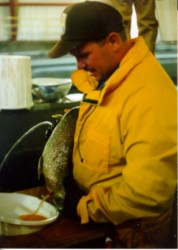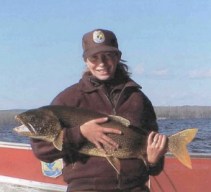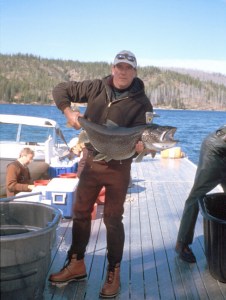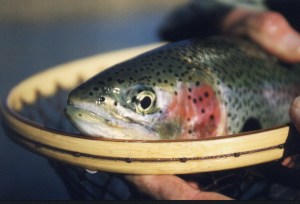|
Early morning sunlight streaks over
the brushy high-plains of southern Wyoming. Gray-green scrub is
bent by incessant wind. And as Pat Malone drives to work every
morning he's probably no different than you. Between gears he
skims over miles of AM-radio static for something better, all the
while thinking about tackling the tame and mundane tasks ahead.
But when he passes through the office door, that's where the
similarity stops. His workday plays out to the sounds of rippling
water and discordant din of pumps. The pungent smell of fish fills
the air.
Pat Malone, Saratoga
National Fish Hatchery, spawns lake trout. Credit
Ed Stege/USFWS.
 |
Malone works at Saratoga National
Fish Hatchery, one of the U.S. Fish & Wildlife Service's trout
brood stock hatcheries -- hatcheries that produce fertile fish
eggs to be hatched elsewhere, grown out, and stocked primarily for
fishing. And although Malone's job of keeping pumps and essential
gear in working order confines him to the hatchery, the fruits of
his and his three coworker's labor has an influence that extends
far beyond this tiny portion of the Wyoming. Saratoga National
Fish Hatchery produces fish eggs -- eventual fish that folks will
try to catch as far away as Arizona and New York.
Each year Saratoga produces up to 3.5 million brown trout eggs,
with half going to the USFWS mitigation hatcheries. These
hatcheries were intended to make up for, or mitigate, the sport
fisheries lost to dams built by the federal government for flood
control and electric power production. The remaining brown trout
eggs from Saratoga go to Indian tribes and states to support sport
fishing. A small portion of eggs go to research facilities where,
for example, they are used to assay chemicals for controlling
parasitic lampreys. Brown trout
is but one species kept at Saratoga. Malone and his co-workers
also work with the largest trout in North America, the lake trout.
Lakers were once abundant in the Great Lakes and sustained a
commercial fishery for some time. But over harvest and accidental
invasion of the parasitic sea lamprey struck a one-two punch;
laker populations hit the canvas. But that's a trend the hatchery
plays a pivotal part in reversing.
Bonnie Johnson, USFWS
fish biologist, readies a 20-pound Lewis Lake-strain lake
trout for spawning.
Credit Dave Erdhal/USFWS
 |
Fortunately in the 1890s lake trout
had been transported by railcars from Lake Michigan to Cinnabar,
Montana, and then by pack horse to Lewis and Shoshone lakes in
Wyoming. Descendants of the Lewis Lake transplants were the
eventual seed for a brood stock that's helping recover lake trout
far away in the Great Lakes. Adult lake trout are spawned every
five years or so at Lewis Lake, the eggs taken back to the
hatchery to keep the brood stock robust and viable.
It's apparently working. Since
1986, Lewis Lake-strain lake trout have been stocked in Lake Huron
with measured success according to Jerry McClain, USFWS fish
biologist. McClain's Alpena Fishery Resources Office monitors the
Huron fishery.
"They're surviving well,"
said McClain. "They're avoiding sea lamprey, reaching
adulthood, and showing up on spawning reefs." There's another
place Lewis Lake-strain fish are showing up -- the ice chest.
McClain notes that based on tagging studies, 75 percent of lake
trout angled from Huron originally came from the Saratoga
hatchery. McClain adds, "Charter boat operators like them,
and the states and tribes want to bring back the lake trout. This
natural top-predator of the Great Lakes is a great fit."
USFWS fish health
biologist, Ken Peters, hangs on to a Lewis Lake-strain lake
trout. The Bozeman Fish Health Center examines ovarian fluid
from wild lakers to detect diseases.
Credit Dave Erdahl/USFWS
 |
The Saratoga facility has a
fortunate circumstance in common with another brood stock
hatchery, Ennis National Fish Hatchery in Ennis, Montana. Both are
free of whirling disease, thanks in part to careful monitoring by
the USFWS Bozeman Fish Health Center. Whirling disease is
insidious and in far too many trout waters across the U.S. Young
trout are most vulnerable to this sometimes debilitating disease.
Fish Health biologist, Ken Peters, says that monitoring fish
health is but a small part in disease prevention.
"Protecting the water supply,
and careful consideration by hatchery managers in keeping sanitary
conditions goes a long way in keeping a healthy brood stock,"
noted Peters. "Clean facilities means clean fish." And
both hatcheries have been successful; between the two of them,
millions of clean trout eggs are produced and distributed for
fishing across the U.S. Rainbows are the primary species produced
at Ennis. Twenty million eggs of six strains of rainbow trout are
produced there annually.
"Brood stock hatcheries seem
to work in the shadows -- the combined effect of these two
national fish hatcheries is tremendous," said Steve Brimm,
the USFWS National Brood Stock Coordinator. "Our facilities
are the source of brown, rainbow, and lake trout eggs that
benefits people in 30-plus states."
Brimm notes that a well-coordinated
distribution of fish eggs assures high genetic integrity of fish
and a low occurrence of disease. Moreover, fish coming from brood
stock hatcheries stimulate the economy. "Fishing is business
in the U.S.," remarked Brimm. "There is a multiplier
effect in the economy; a dollar spent growing fish produces that
many more dollars in the economy."
Rainbows from Ennis National Fish
Hatchery fill angler's nets in state and tribal waters
across the country.
Credit Craig Springer
 |
A recent peer-reviewed economic
study bears that out. According to USFWS economist, Dr. Jim
Caudill, mitigation trout hatcheries in the Southeast, many of
whom get trout eggs from Ennis and Saratoga, are a huge stimulus
to the economy.
"Stocking trout in the
southern tailwaters below dams is like pouring fertilizer on
plants," said Dr. Caudill. "Stimulate the roots a little
and the return is a bounty of fruit." That bounty is reaped
at the cash register and the county treasurer's office. For every
dollar the USFWS spends raising trout in the Southeast, it
generates $141.00 in economic effects and up to $7.85 in state and
federal taxes.
Besides putting coin in the coffer,
Brimm points to another valuable trait of the brood stock
hatcheries not easily measured: know-how. When a wild stock of
fish gets in trouble, it's the technical know-how from brood stock
hatcheries that's put to use. Hatcheries play a huge role in
imperiled species conservation. Cases in point -- Arctic grayling,
Apache trout, lake trout, coaster brook trout, and greenback
cutthroat trout conservation.
"Our greenback brood stock
under development at Saratoga will play a significant role in the
Colorado Division of Wildlife's effort to bring this trout back
from near extinction," said Malone. "Successes with
greenbacks are mounting and it could be the first fish ever taken
off the endangered species list."
A significant achievement indeed,
and in the end, the American people will benefit by having an
intact ecosystem, and yes, more opportunity to go fish.
As Malone turns out the lights and
locks the door to head home, the ramifications of the workday are
barely perceptible. Fact is, however, work at this small spot in
southern Wyoming will send ripples across the surface of far away
waters and positively affect the lives of many people Malone will
never meet.....
All content and photos © 2001 by
Craig Springer and other credited photographers
|